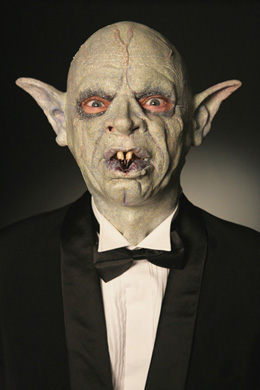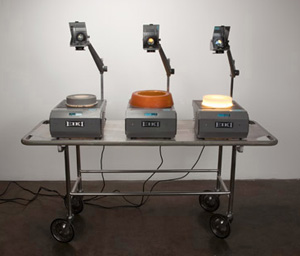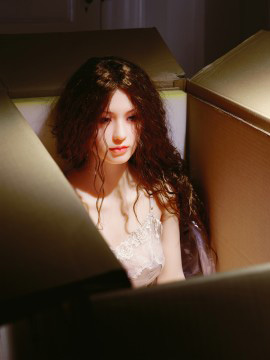Manufactured Bodies
John Haberin New York City
Gillian Wearing, Robin Hill, and Laurie Simmons
Lumpy, aging bodies hide painful secrets. Hospital gurneys give no rest and no recourse from irreversible decline. Life-size dolls make a woman's bare weight impossible to ignore. So what if they are slim, ideal beauties? Desire is what is left over after comfort is gone.
At least it seemed that way in Chelsea. Gillian Wearing traces the stages of life as fragile affairs. Stare too long, and the moment dies. Robin Hill leaves the body implicit in hospital equipment, but as viewed under a laboratory slide. The art's clarity and physical presence make the diagnosis that much more chilling. Laurie Simmons adopts a sex doll, and it becomes so at home that she adopts another to keep them both company. How can manufactured bodies suffer so much anxiety and decay? 
Not all, though, is doom and gloom. These are women artists, and they are recovering a woman's body for itself and not for men. With Wearing, even the plainness of her subjects dignifies everyday life and honest feelings. Tenderness vies with guilt, and accusations vie with confessions. Hill allows people and objects to have lives of their own, and Simmons allows manufactured sex objects to have fantasies—not unlike her own. Where her early photos of dolls confronted readymade images of male desire, now they get the run of the place.
Wearing works in video with starts and stops, Hill in sculpture or installation, and Simmons in photography of appropriation. Each, though, pursues how art's images and materials alike create presences. They could almost be painting, and in fact Hill throws in an easel while another artist, Robert Jack, constructs painting from the anatomy of a cat's eye. They put the viewer on the spot, male or female, but not as a lecture. All this weight can get heavy-handed, and Wearing has trouble leaving anything unspoken. With Simmons, though, a heroine of feminism and Postmodernism discovers illusion.
True confessions
Gillian Wearing betrays secrets. She has her subjects confess to their desperation, and she counts catharsis as nobility. She also wants some of that desperation, catharsis, and nobility for herself. In three self-portraits she poses as Andy Warhol, Robert Mapplethorpe, and Diane Arbus. Two other large photographs reenact the elaborate, rotting beauty of Dutch still life. In each case, the choice of classics in black and white all but shouts high seriousness.
At a given moment, Arbus's subjects may boast of their ignorance, including ignorance of their sullen strangeness. At the next, the boast barely covers a private agony. Arbus herself appears caught in their dilemma. For a visionary and an outsider, it takes one to know one. She offers a bridge from Berenice Abbott, over Robert Frank and The Americans, and into the turmoil of the 1960s, and no wonder if the bridge is shaky. She could be mocking the very people who pose for her, identifying with them, pleading for them, obliging one to confront them, or uncovering their beauty, and the strangeness of their beauty still will not go away.
Wearing loves high seriousness, and it can grow numbing, for all the shocks and despair. Two small statues, literally and figuratively on pedestals, describe fleshy, suffering everyday heroes. The standing woman helped on 9/11, while the man cowering beneath the clothing of the homeless works for the police. For nearly an hour's video, men and women admit to adultery, murder, or just as guiltily going along for the ride. The image here notwithstanding, they look more homely than evil. The banality of evil has a plain British complexion.
Wearing has surprises in store in her own way. Back downstairs, seven glowing portraits in black-and-white, from 2005, have the provocatively casual title Snapshot. With their thick colored frames, they look at once more antique and more tacky, like light boxes. The subjects are again clumsy and ordinary enough—a girl balancing her violin, a mother nursing, or an older woman slumped in an easy chair. And then all at once the violinist's arm moves or a woman leans forward on her steering wheel. The random changes disturb the smoothness and reality of the gallery as well.
The hour's confessions disrupt real time, too. The faces hardly move, but the lips surely do—only never quite in synch with their speech. Past deeds haunt present consciousness, and the present never can entirely catch up. Yet for Wearing a formal disturbance is never enough. The video's box must represent a confessional. Its plainness must make the gallery's proverbial white cube a confessional as well. It nearly ruins the surprise to learn that the portraits downstairs represent a woman's seven life stages.
Nothing less than psychodrama will do. One last video lines up half a dozen men and women like terrorist or criminal suspects, the woman in a head scarf, while a young man with a lower-class accent and the UK equivalent of bling rants at them. Then he must answer for his ranting, and the whole direction of the scene becomes the issue. Perhaps it comes with the inheritance of British art, after Francis Bacon and Lucian Freud, although Leon Kossoff can still make a landscape quiver or lend a portrait in oil a fresco's silent flesh tones. Wearing indeed calls the confessional Secrets and Lies after the British film. Still, if formal and temporal invention gets in the way of secrets and lies, maybe one day she will accept that herself.
Life support
One knows things are grim when the art wheels in on a hospital gurney. Robin Hill's gurney holds three projectors, each with a slide carousel that has turned to resin. Are the multiples design choices or as coldly replicable as Brillo boxes? Is each rough, opaque mass an act of preservation or decay? It is obviously not functional, not when the projectors would once have held transparency masters—those acetate sheets that, you may recall, preceded PowerPoint. No one says any longer that painting is dead, but sculpture here is in critical condition.
Or am I just projecting? Like Robert Heinecken between photography and television, Hill may not make experimental art so much as a laboratory, stocked with dated equipment. Some, like pipettes, comes from a hospital and some, like a well-crafted wooden easel, from the studio. Almost everything, however, holds signs of life. Felt specimens on glass shelves even form a double helix. Still more fabric takes up the easel, as white as untouched canvas.
 Hill insists that "Case Studies" does not turn on nostalgia, but rather the integrity of objects. More than one work uses the semi-official emblem of uniqueness, snowflakes—in one instance, a literal carpet of them. Regardless, she is manipulating the objects, so that their integrity comes into question. In the process, she conjoins the fragile conditions of art, technology, and life. The next time I consign used electronics to the trash heap, I shall have to think of it as a metaphor for myself. Maybe, like an artist, I could learn to recycle.
Hill insists that "Case Studies" does not turn on nostalgia, but rather the integrity of objects. More than one work uses the semi-official emblem of uniqueness, snowflakes—in one instance, a literal carpet of them. Regardless, she is manipulating the objects, so that their integrity comes into question. In the process, she conjoins the fragile conditions of art, technology, and life. The next time I consign used electronics to the trash heap, I shall have to think of it as a metaphor for myself. Maybe, like an artist, I could learn to recycle.
Fans of trashy conceptual art and the handmade can get at each other's throats—in which case Hill's stacked felt, like bandages, may come in handy. Both sides, however, want something more quirky, memorable, and even dysfunctional than the latest consumer product update. No wonder much art about science ends up borrowing nineteenth-century instruments, as in an old curiosity shop. It does not have to be that way, not after the Bauhaus or Andy Warhol, and Hill also pairs an array of jars with polka-dot vinyl that could pass for a shower curtain. But that is the messy state of the art these days, and she renders it with pristine clarity. Maybe someone somewhere is still using slide carousels for an art-history lecture.
If they do, animal behavior researchers will have something new on their plate. What if a cat could paint? As it turns out, one artist is at his best on a steady diet of Meow Mix. Robert Jack takes the design of his abstractions from the "Anatomy of the Eye," including a cat's focus on the "linear horizon." The resulting horizontal of Prey and Predator, in thin vertical stripes of subdued color and varying length, resembles an Asian scroll. Perhaps the cat is a Siamese or Himalayan.
The inky texture results from casein on wood, and Jack derives his other modular but variable compositions from biological patterns as well, such as rods and cones. He relates their near monochrome to such limitations of the eye as human vision in low light and the polarized vision of one of Thornton's subjects, bees. I can think of more daring parallels between biology and art, although Jack's works on paper actually suffer from seeming sketchier. They can easily draw the scorn of a critic for mere "illustration," even if one might never know what he is illustrating. One can imagine a less tasteful or less obscure space between abstraction and representation. Call the work polarizing, but that cat can sure paint.
Living dolls
Laurie Simmons may finally have found her equal, at least in size. The "Pictures generation" of the early 1980s was notoriously unforgiving, especially when it came to sex. How dare you laugh at my sick jokes, Richard Prince seems to say, and how dare you take seriously the male artists whose work I photograph, in the case of Sherrie Levine? In the case of Barbara Kruger, Cindy Sherman, Marilyn Minter, or Aneta Grzeszykowska, how dare you so much as look—and how dare you not? So soon after Andy Warhol and Warhol's influence, appropriation had become outright sexy but also downright puritanical. Simmons merely played with dolls, in a postmodern generation that hardly believed in a more primordial unconscious, but she could play the sexpot or the puritan as well as any.
Cindy Sherman undermines pretty much every gender stereotype ever imagined, along with the whole idea of identity, but somehow every one of her ever-changing roles seems hers. Kruger and Jenny Holzer debunk every slogan, but the words still seem biting, familiar, and even mine. In contrast, like Annette Lemieux with her pink child's hanger and lead toy soldier, Simmons suggests a world that relegates women to childhood, but she definitely has outgrown hers. If the women in her images seem lost, in dollhouses or modern offices, do not blame her. If they seem cut off from human contact, even if now and again men press in on them, so what? They are, after all, only dolls. 
Now the dolls seem practically at home—in, as it happens, the artist's home. As they say, size matters, and she started her 2010 series by ordering one of those life-size "love dolls" from Asia. She seems to treat it as an equal or an alter ego, with the freedom to find itself in her personal surroundings. She speaks of getting to know it, and the show's title, "The Love Doll: Days 1–30," very much suggests a diary. Without the awful duties for its usual clientele, it can clamber over a fence or bask on a bay window in the sun. As if afraid that even she could not satisfy it, Simmons eventually orders a second, a white woman, to keep it company.
Obviously one should be careful about taking anything at face value, especially with female faces—and elsewhere, with "Grand Illusions," the Met has seen her devices as central to staged photography for over a century. The sunlight is real, but the mobility is an illusion. The sex appeal is real, but that is very much the problem at hand. The doll still has to play suspiciously limited roles—the bride, the dreamer, the poster girl in the snow, the girl with her candy hearts, or the Asian sex goddess with her scant clothing and cheap jewels. When the second doll comes out of its box, its white dress and fixed stare could belong to a zombie stepping out of the grave. Simmons is getting to know only herself and the culture that she is helping to stage.
It is a spookier culture than she has often allowed all the same. She could well have invited herself into their world rather than the other way around, and her house has become Ibsen's dollhouse. The illusion alone marks a change. One could call her work meticulous, but that suggests a traditional realism with its desire to deceive, whereas her whole career is about unmasking deception. One never doubted that one was looking at a few props in a literally small world. It had clear physical boundaries from the real world, even if men and women in the real world are stuck within its mental boundaries.
Then again, the love dolls should get one to look again at her small world. It was the raunchy world of East Village art, and Simmons was part of a show of "Visions of Childhood" with some nasty characters. The new series catalogs many of her previous ones, such as swimmers, and toys by their nature mean playing around. No doubt she once really did play with dolls as a girl, whereas she surely never played with life-size Asian sex dolls. One should not start to see her earlier work and its single, almost obsessive theme as confession rather than observation. I may, however, start to see it as less glib and puritanical after all.

Gillian Wearing ran at Tanya Bonakdar through June 24, 2011, Leon Kossoff at Mitchell-Innes & Nash through June 18, Robin Hill at Lennon, Weinberg through February 19, Robert Jack at Josée Bienvenu through February 12, and Laurie Simmons at Salon 94 Bowery through March 26. A related review looks at Gillian Wearing in retrospective ten years later at the Guggenheim.




